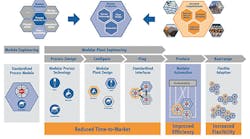It's a bad idea to glue Legos or other building blocks together because you can't take them apart, reassemble and rebuild, or create something new and different later. To avoid similar restrictions, discrete manufacturers have been seeking less constrained devices, and developing more modular equipment and production lines for years—but lately process users are seeking the same flexibility and advantages.
Module Type Package (MTP) is a standardized, non-proprietary way of describing process automation modules from individual components up to production skids, which lets them work with other modules, and fit more easily into larger applications. These common, shared definitions of basic capabilities, interfaces and services reportedly let MTP modules plug-and-play with other compliant devices and systems. This can save huge amounts of time and labor that's usually spent on programming, configuration, data conversion, networking and getting non-interoperable devices to work together.
"MTP can save up to 50% on the engineering effort required to build process plants, including skids and package systems," says Axel Haller, global segment manager for specialty chemicals and life sciences at ABB, and chair of the MTP working groups at ZVEI, the Electro and Digital Industry Association. "Users can do a proof of concept (PoC) by contacting their suppliers, adapt it to their processes, and see the benefits for themselves. This is possible because MTP is agnostic and independent, so any five modules can connect to five different PLCs or DCSs. Because they're all using the same language, MTP can also help a supplier with a specific PLC or DCS link to others without having to do as much reconfiguring, or spend as much on fees for optional modules. Easier connections with MTP can also help suppliers protect their intellectual property."
Pieces in the playset
Presently under development, the MTP standard effort was started in 2014 by the NAMUR association of process industry end-user companies, which drafts recommendations with help from ZVEI and other groups and suppliers. NAMUR reports that MTP is designed to use intelligent equipment modules for production, improve flexibility and increase efficiency, enable package unit integration, allow quick and easy adoption of new processes, fulfill individual users requirements, cut engineering and automation costs for plant conversion, and reduce time-to-market for products.
"MTP consists of standardized descriptions of a process module's functions, which can be used like a mouse driver to integrate mixers, reactors, heaters, distillation units and other devices with their controls and other modules," says Dr. Jens Bernshausen, PLC and process control technology manager at Bayer, and plug-and-produce working group leader at NAMUR. "The engineering workflow for MTP begins with making sure each standardized module has its own control capability, and using AutomationML (AML) data format and OPC UA networking to coordinate between modules. MTP is technically and vendor neutral, so its five main aspects of process control, HMI, maintenance and diagnostics, alarm management, and safety and security can be employed or not by each user. For instance, they can move static and dynamic data for their HMI from a PLC to their DCS within MTP's service-based architecture."
Jesse Hill, process industry manager at Beckhoff, adds that MTP allows secure interoperability between automation systems from different vendors, and eases development because users can employ modules from suppliers that know its production best. "Because each MTP module has its own controller, it can import HMI designs and other data into the controller to make an MTP file, which it can export to other systems, orchestration and higher-level controllers," says Hill. "MTP is a way to take engineering and programs from a module or library, and integrate them into a DCS. For example, an MTP file can integrate HMI screens into a DCS, which reduces programming because they don't have to be recreated every time. This is using IT-based strategies that have been available for a long time."
Timeline and schedule
Bernshausen reports that NAMUR, ZVEI and their joint working groups are writing a German national standard for MTP, entitled VDI/VDE/NAMUR Guideline 2658. So far, they completed and published three sections, including basic concepts and interface definitions, descriptions and modeling of HMI to process equipment assemblies, and interfaces and libraries for basic object types. The draft of the fourth section, services for process control equipment assemblies, is being reviewed, and is expected to publish late this year or in early 2022. Several suppliers plan to release MTP products as soon as the fourth section is approved. Sections for standardizing 10 more functions are in the works, including monitoring and diagnostics, safety and cybersecurity.
The organization is also integrating MTP with its NAMUR Open Architecture (NOA) for adding and monitoring sensors, and reducing PLC workloads by using a second channel to deliver applicable data directly to Industrial Internet of Things (IIoT) devices and cloud-computing services. Finally, NAMUR also plans to get MTP adopted as an International Electrotechnical Commission standard, entitled IEC65E/663/NP, "Automating engineering of modular plants."
"The working groups are determining how MTP modules should do maintenance and diagnostics, alarm management, and safety and security," says Bernshausen. "Using MTP modules lets users go from spending a month or more designing, integrating and configuring a skid or package system to doing it in just a few days. Plus, MTP isn't just useful for new devices and greenfield applications, but it can also upgrade existing equipment and brownfield processes. For example, it's possible to add modular components to a steam unit, and use MTP to integrate them more easily, which can also enable equipment leasing or buying steam or other production on a subscription basis."
To deliver MTP's potential benefits, Bernshausen adds that users should ask vendors for more modular, standardized and pre-tested products, and specify MTP for them. "It used to take a lot of time to design and configure a skid or other equipment. Users ordered pre-engineered packages and automation systems, which might not interoperate when they tried to integrate them," says Bernshausen. "Now, MTP lets users employ the best controls and other devices available from each supplier, and be more certain they'll work together."
Moving to modular
"Many processes and batches are getting smaller, more numerous, and have more varied specifications, so process engineers want to standardize their individual production units, such as mixers, fermenters and skids, and combine new plants made of these standardized modules, so they can gain flexibility and reduce costs," says Dr. Eckhard Roos, head of industry segment and key account management for the process industries at Festo. "MTP and standardized modules can also help users test new processes, and handle them as they also become more numerous."
While its origins and methods can be traced to the well-known S88 batch standard, Roos reports that MTP is based on NAMUR NE 148 and its main recommendation that each module possess its own PLC to control its sensors, I/O points, actuators and other components, be able to act on them and connect to upstream and downstream modules, such as SCADA systems and DCS, and integrate these standardized modules with the least effort.
Also read: 7 module type package resources
To enable a device as an MTP module and link it with a SCADA system, Roos explains its engineering process needs to be defined by having its supplier provide the data needed for it to be represented in the larger SCADA environment. This includes number of devices, where it's located in the interface, what its colors mean and other relevant details. To connect modules and services with a DCS, MTP is loaded into its orchestration layer, where it can provide services, properties of services and interfaces. "If everyone follows this standard, then OEMs can pick any PLC for the equipment they build, and their data can be represented immediately in the system those devices join," says Roos. "We can now connect a Festo PLC to an ABB or other SCADA systems, and it's easy to make those links with little effort. In the past, the PLC, SCADA and other devices came from one supplier, and if they didn't, there were connection and performance problems.
Roos adds that NAMUR's working groups overcame these traditional interoperability problems by getting everyone at the same table, and defining the data sets needed to represent MTP modules in SCADA, DCS and other supervisory systems. They agreed to use AML as the way to get data for graphics to supervisory systems, and agreed to use OPC UA for communicating between runtime operating systems. "This lets OEMs choose what they want for automation, encourages existing suppliers to join, so they don't lose business, and lets new suppliers come in, too," says Roos. "MTP and standardizing on AML also means OEMs don't have to know how to program every type of PLC, and can instead learn just one, which is less complex, cuts costs, and is easier to maintain and fix."
Charlie Norz, automation product manager at Wago reports it used to be an engineering feat and very time consuming to get a DCS and its orchestration architecture to show the operations of individual equipment and add new ones. "System integrators and OEMs had to coordinate with their DCS supplier, and exchange memory locations, diagrams and screens, and secure P&IDs to be recreated in the HMIs, which could take hundreds of hours," says Norz. "Now, they can use MTP to export files to a DCS more easily, which can show how graphics should look, share memory locations, and automatically provide required look and feel. MTP can save many hours by automatically drawing the data that needs to be shown on an HMI. For instance, a typical water/wastewater facility may have four possible suppliers, but following MTP makes it easier for them to pick the equipment that best suits their needs. MTP makes controls more readily available because its modules interface with the orchestration later."
Norz reports that Wago has added MTP function block libraries to its eCockpit PLC software, so users can export AML files to their DCS, or let suppliers add MTP to the controls in the products they're providing to others. "For instance, a hot water system manufacturer may have a memory location for a start/stop function handling temperature measurements or flow rates, and MTP can expose that information to the orchestration system and the DCS can use it. This flexibility saves time compared to the rigid and manual methods of the past, but MTP also helps users maintain their processes by making it easier pull, replace and integrate new devices."
Proof in pilot projects
While MTP hasn't been launched in mainstream production applications—at least none that have been disclosed—it's been proven in several modular PoCs and pilot projects.
Evonik recently implemented MTP modules in three projects. The first pilot is a modular, lab-based plant at its facility in Marl, Germany. It includes components from ABB, Wago and Orca, which were successfully used to start up an orchestration prototype, provide fast exchangeability, and use MTP to streamline development of HMI, alarm management, runtime communications and services.
The second is a PoC involving module orchestration via IIoT that's is also at Marl. It integrates components and software from Phoenix Contact and PTC, including its ThingWorx IIoT platform, which can reportedly fulfill the technical requirements of the process orchestration later (POL) for MTP use cases. It's also expected to enable easy integration of added functions, such as access to engineering and operations data, PIMS and SAP.
Located at Evonik Singapore, the third pilot uses MTP to integrate refrigeration units from Engie for synthetic amino acids into a DCS. It employs devices and software from Yokogawa for plant automation, as well as Siemens for module automation and operations. It was successfully implemented in 2019.
Similarly, the "invite" project is a modular plant developed by Bayer, Siemens and Festo that's commissioned and functioning. It integrates modules with Siemens' MTP-ready PCS neo AS and S7 PLCs networked with Profibus DP and Profinet, as well as Festo PLCs serving as MTP modules networked by OPC UA.






